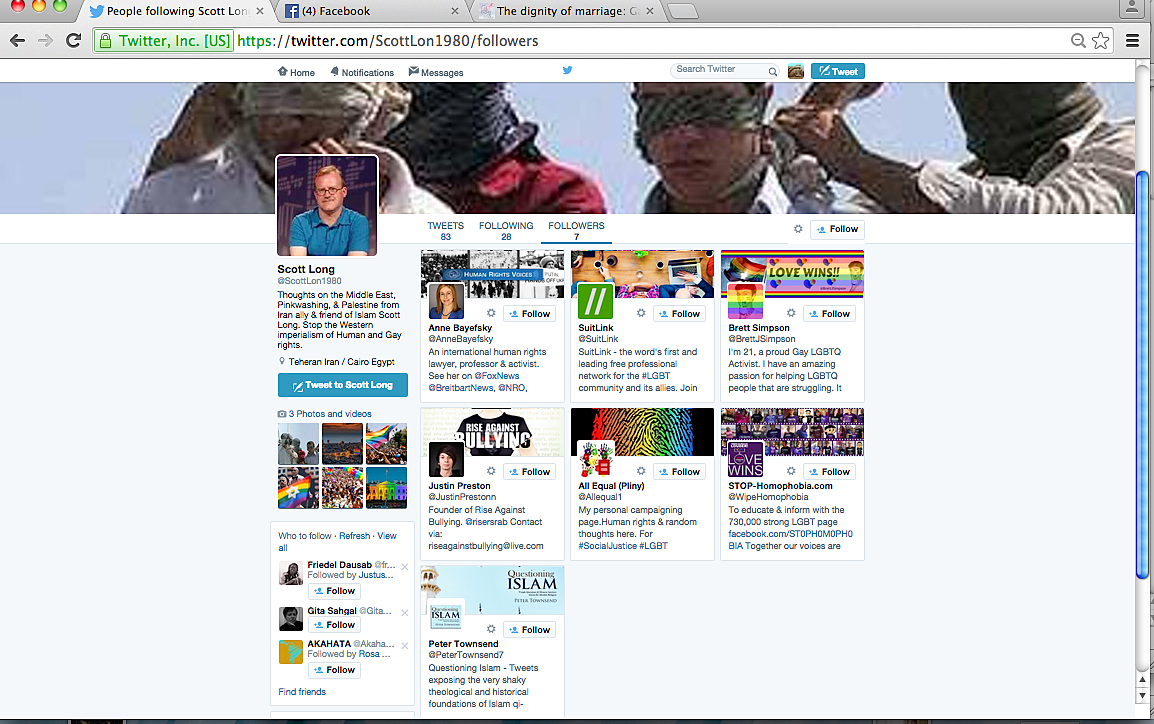Everybody on earth knows that a deal on Iran’s nuclear program was announced in mid-July. Everybody also knows that this apparent step toward peace launched a new stage in an old war: of propaganda.Proponents praise the possibility of a historic opening. Opponents—who include Israel, Saudi Arabia, and the Republican Party—warn of disaster. Both sides want to expand their constituencies. In Western countries, gay communities—small but politically influential—are more and more the target for just this courtship and recruitment.
The right-wing pundit Amir Taheri greeted the nuclear deal with a storm of tweets and screeds condemning it. One 140-character charge drew special attention.

Anyone’s first reaction would be some version of “My God.” It sounded horrible. I wrote to Taheri asking for more information—and so, judging from Twitter, did at least three other people.
But the story quickly began to show cracks. Taheri didn’t reply to me, or anybody. I sat down that night with a Farsi-speaking friend and began searching for the story in the Iranian press: under the youth’s name, under various other key words. It didn’t turn up anywhere. I wrote to the Toronto-based Iranian Queer Organization (IRQO), a diaspora-based group of LGBT Iranian activists with which I’ve worked closely over the years. They searched the media as well and found no sign of it. They also reached out to contacts in Isfahan. On Friday morning, they told me no one there had heard of the story, either.
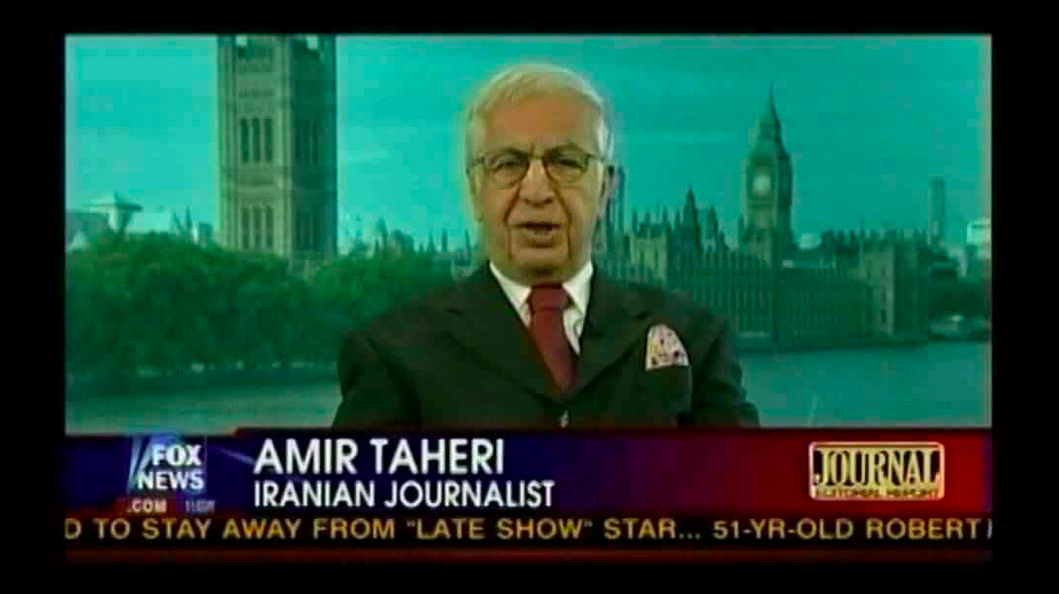
[Taheri on Fox News]
Amir Taheri lies a lot. Eight years ago, Jonathan Schwartz called him “one of the strangest ingredients in America’s media soup,” adding, “There may not be anyone else who simply makes things up as regularly as he does, with so few consequences.” An arch-conservative protege of the Pahlavis and an editor of the Tehran daily Kayhan under the Shah, he repeatedly fabricates stories about Iran to please right-wingers in his adoptive West. Most famously, in 2006 he claimed in Canada’s National Post that a new dress-code law in Iran would impose special clothes on religious minorities, including yellow badges for Jews. Many conservatives swallowed the story; even the Canadian Prime Minister repeated it. But it was a complete falsehood, and after a huge furor the National Post retracted it and apologized: “It is now clear the story is not true. . . . We apologize for the mistake and for the consternation it has caused.” (The Post also noted that Taheri went “unreachable” after his fiction was exposed, rather as he did on Twitter.) Undeterred, in 2008 Taheri concocted a quote from Ayatollah Khomeini, complete with a fake citation of an invented source; American neoconservative luminaries duly repeated it. In 2002, Taheri claimed that “Osama bin Laden is dead . . . the fugitive died in December and was buried in the mountains of southeast Afghanistan.” The list of his duplicities goes on and on. In 1989, an academic reviewing one of Taheri’s books
detailed case after case in which Taheri cited nonexistent sources, concocted nonexistent substance in cases where the sources existed and distorted the substance beyond recognition when it was present. … [The reviewer] concluded that Nest of Spies was “the sort of book that gives contemporary history a bad name.”
Larry Cohler-Esses condemns Taheri as a “journalistic felon,” part of a “media machine intent on priming the public for war with Iran.”
There are ample grounds for skepticism about stories Taheri spreads. But skepticism doesn’t make headlines. Propaganda’s best friend is the ambition of the press. On Thursday, a reporter for the UK-based Gay Star News also tweeted to Taheri.
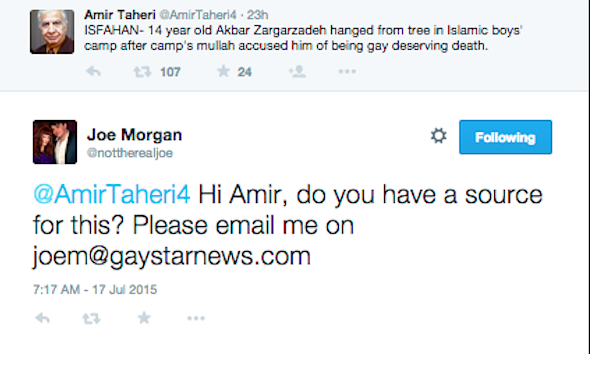
Taheri did not answer him, either. I know this because the reporter didn’t wait for a source. About twenty-five minutes later, his story—“GAY TEEN, 14, ‘HANGED FROM TREE`”—topped the website of Gay Star News, and it said Taheri hadn’t told them anything. In other words, their entire account was based on one single tweet with no evidence behind it. This tweet was special, though. The topic of gay killings in Iran has shown its passionate drawing power over a decade, its ability to keep queers clicking. Gay Star News wanted the clicks for itself.
The reporter clearly never asked Iranian LGBT activists or groups for their take. It was more important to get the headline out there. I wrote to Tris Reid-Smith, Gay Star News‘s editor, and asked, “Is this standard practice — to run a story based on a single, unsourced, unconfirmed tweet from someone who declines to answer follow-up questions?” Tris rather cannily refused to reply in writing; he wanted to talk by phone. My phone in Cairo is tapped; I declined. I wanted this on the record, but not State Security’s record. If Tris still wants to answer my question, he is welcome to do so here. Gay Star News has since added a few sentences to its story, saying:
we should note Iranian LGBTI networks have not confirmed the story. Some critics have questioned Taheri’s reliability. … UPDATE: For clarity, GSN has noted from the outset this report has not been independently verified. Taheri is yet to reply to our questions seeking to substantiate his claims. We urge caution but feel it is in the public interest to report the claims, given they are gaining traction on social media.
Let that final sentence revolve in your mind. What defines news these days isn’t truth. It’s traffic. (I have saved a screenshot of Gay Star News‘s original article, prior to the caution-urging, here.)
And of course the story spread. Neoconservative propagandist Ben Weinthal tweeted it no fewer than five times:
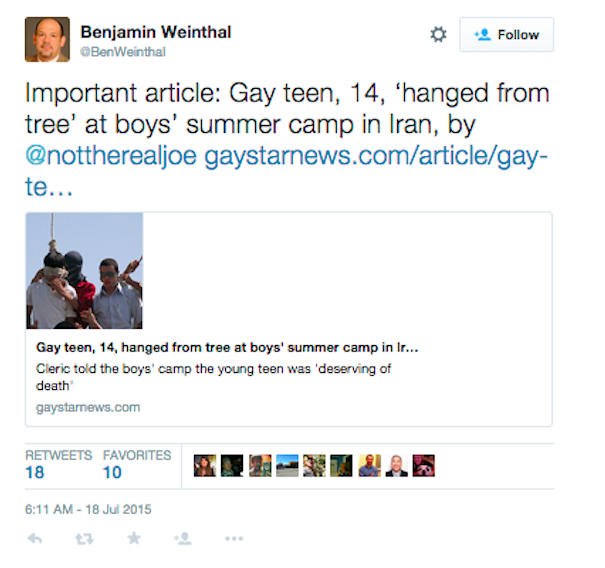
Weinthal is a lobbyist for the right-wing, pro-Israel Foundation for Defense of Democracies. One of his jobs is to drum up support in gay communities for hardline policies against Iran. I have detailed some of his many misrepresentations here. His desperate drive to ensure Taheri’s tweet gets coverage suggests what the motives at work are.
No one should ever minimize the real, documented, and terrible human rights abuses in Iran. But credulity for suspicious stories devalues the true ones. Given Taheri’s record, and the tangled political context, there is no reason to credit this tale without corroboration.
And here’s the thing: we have been through this before, and learned nothing. Look at the photo Gay Star News attached to its article.
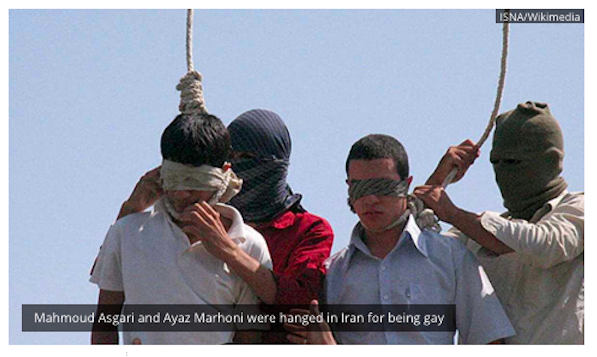
[From Gay Star News, 17 July 2015]
That famous image, exactly ten years old, reverberates with misery and horror. And cynics and opportunists know it as proven clickbait. In fact, the two youths were not executed simply for “being gay.” They were convicted of the rape, at knifepoint, of a thirteen-year-old boy. Claims that they were gay lovers circulated widely among Western activists; but no clear evidence materialized to confirm them.
International tension shaped the context, then as now. In June 2005, Mahmoud Ahmadinejad was elected President of Iran. The religious hardliner’s victory intensified foreign fears of Iran’s nuclear plans; Ahmadinejad moved quickly to quash negotiations with European powers and smear reformists as appeasers. Western conservatives stoked those fears, and rumors roiled. Immediately after the vote, a website affiliated with the Mujahedin e Khalq claimed Ahmadinejad had participated in the 1979 seizure of the US embassy in Tehran. The Mujahedin is a wealthy, cult-like Iranian exile group widely despised in the diaspora, but closely tied to many Western politicians. Amir Taheri leapt in; he alleged in print that Javad Zarif—then Iran’s UN ambassador, now its foreign minister—had joined the hostage-taking. (Another fabrication: Zarif was studying in the US at the time.) That summer, a charged, familiar storm-cloud of fact, anxiety, and speculation swirled round the subject of Iran.
On 19 July 2005, the two teenagers were hanged in Mashhad. Reports in the local and national Iranian media said clearly they had been tried for tajavoz (rape) or lavat beh onf (“sodomy by force,” or male rape); the Quds newspaper in Mashhad quoted both the thirteen-year-old victim and his father. Another website of the Mujahedin e Khalq, however, published a piece on the execution aimed at Western audiences, and omitted the rape charge. It was almost certainly the Mujahedin who pointed out the story to UK lone-ranger activist Peter Tatchell -- who had a record of publicity-seeking animosity to both Iran and political Islam -- and suggested a “gay” angle. On July 21, Tatchell’s OutRage website blared, “IRAN EXECUTES GAY TEENAGERS,” above the pictures taken from the Iranian press. Tatchell claimed, falsely, that Iranian media had not mentioned the rape, and that the pair were originally charged with consensual sex: setting in motion a stream of fictions that didn’t stop for months.
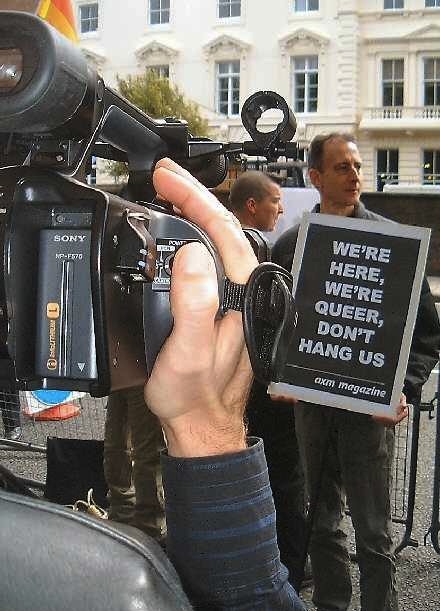
[Mr. DeMille? Mr. DeMille? TV crew films Peter Tatchell at a demo over the Mashhad case, 2005. Photo by UK Gay News]
With panic over Iran already in the air, the photos went vastly viral. If politics motivated some to promote the story, for others it was publicity. (Doug Ireland, a US gay writer with no prior knowledge of Iran who nonetheless rode the story to a new journalistic job, told me his blog got 60,000 hits the first day he carried the pictures.) As more facts came out and the tale seemed less plausible, its proponents got aggressive: not only with doubters, but with the protagonists. Tatchell, for instance, belittled the alleged rape and suggested the victim wanted it: “It could be the thirteen-year-old was a willing participant.” Meanwhile, the story’s popularity led to a desperate search for sequels, for new “gay victims,” that stretched for years. Virtually any execution for rape reported in the Iranian media—even of male rapists of women—could be arrogated or mistranslated as a punishment for consensual gay sex. In a grim and grotesque irony, the quest helped produce the dead. In 2007, Tatchell intervened in the last-ditch appeal of an Iranian prisoner on death row, also for the rape of a thirteen-year-old. Makwan Mouloudzadeh had been framed in a village vendetta; there was no real evidence he’d had sexual relations with the child, much less any other male. Instead of maintaining Makwan’s innocence, though, Tatchell falsely alleged the child was Makwan’s “partner.” Allies of Tatchell started a letter-writing campaign to Ahmadeinjad pleading for the “young homosexual Makvan,” arguing explicitly that he was “‘guilty’ of having loved a peer when he was thirteen and having sexual intercourse with him.” They incriminated the man they were trying to save. Makwan, neither homosexual nor a rapist, was hanged.
The Mashhad story survives, immune to its malign consequences. Taheri certainly knows it—he surely suspected a fourteen-year-old victim would make his tweet go viral. The youths’ images are memed and manipulated everywhere. Sometimes the uses are political:
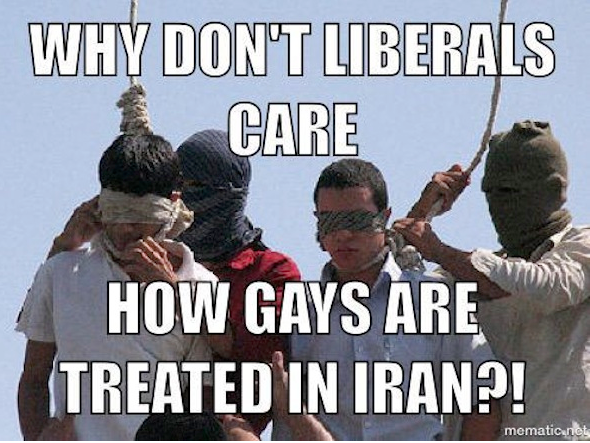
Sometimes they are mythological figures, as if the kitsch of Shi’ite religious iconography melded with the preoccupations of San Francisco.
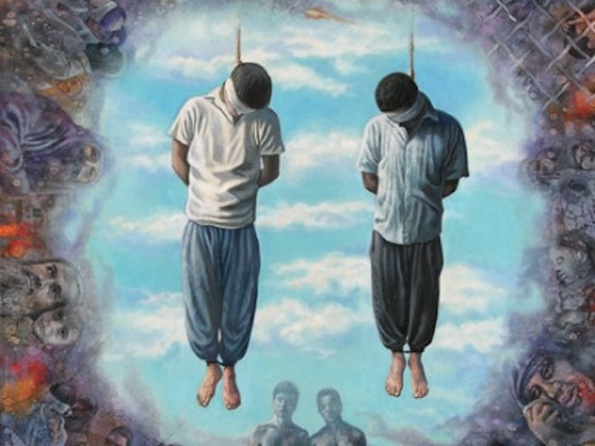
[The Ultimate Penalty: painting by Miguel Tió]
But they remain, always, “the sacred gay martyrs of Iran.”
An hour or two after the Gay Star News story appeared, Tatchell seized the opportunity, announcing a “vigil” to commemorate the tenth anniversary of the youth’s deaths.
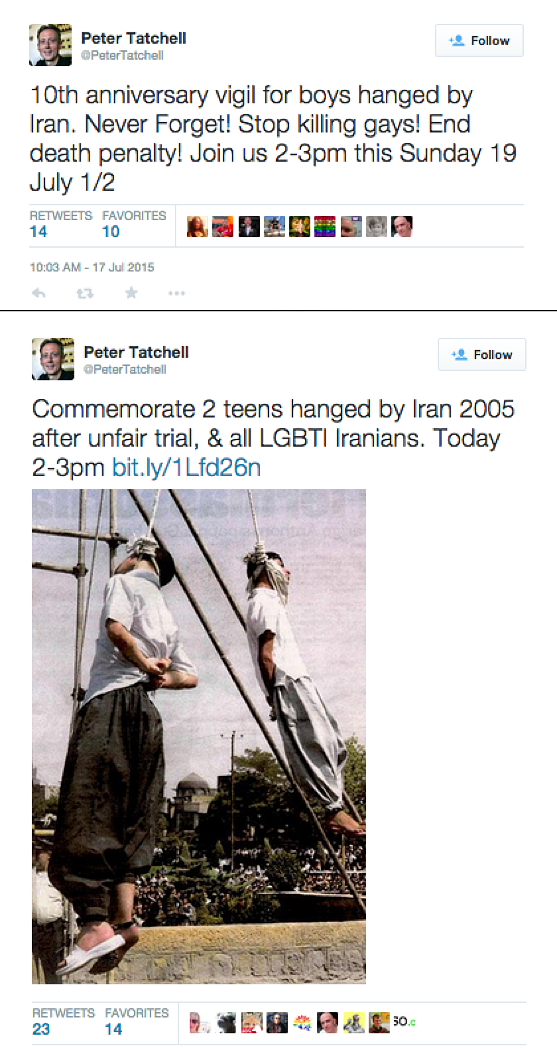
“On 19 July, we stand for life, liberty and love,” Tatchell said at the demo. But think what that rhetoric obliterates. If their thirteen-year-old victim’s story was true, what would he say about those words? Most human rights activists know that you can oppose grave abuses, like the appalling execution of children, without spinning narratives of absolute innocence or “love.” But to do that requires abjuring sentimentality, and acquiring maturity.
A deep narcissism lies pooled here. What does “never forget” them mean, when you never knew anything about them in the first place? No one has ever seriously sought to learn facts (rather than weave romances) about the youths’ lives; no one ever showed the least interest in the thirteen-year-old they allegedly brutalized; no one has ever tried to find their families, and hear what they think of their sons’ pictures being broadcast in this way, or inserted into a foreign story about “gayness.” The boys are silent. Their muteness is their appeal. They offer a clean field for Western political and erotic fantasies; they’ve withered to ventriloquist’s dolls for Western voices. The indignities they suffered before death have been succeeded by a further descent, the indignity of being erased in the imperial name of memory. What Tatchell wants remembered is not the murdered youths. It’s himself.
Strangely, I took two different tacks with Amir Taheri. The day after I politely asked him for information, you could have found me on Twitter writing in quite a different tone:
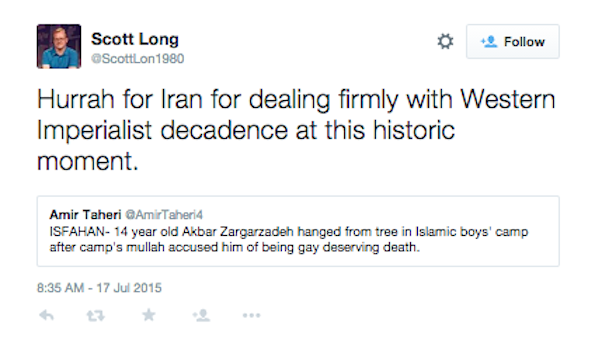
Except that was not me. It was an account someone set up under my name about a week ago, which has been firing off tweets to Egyptians and various right-wing Westerners ever since. It says I’m a pro-Iran Islamist. It uses an old picture of me, and the inevitable photo of the hanged Iranian youth.
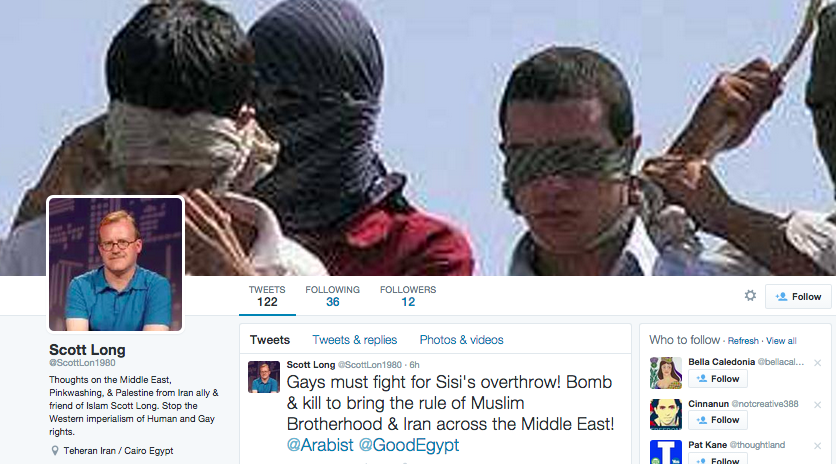
The account is not a “parody.” Not just that it is not funny: it is trying to get me arrested. It makes out that I support banned insurgent movements and want the Egyptian government overthrown. These messages it forwards to Egyptian tweeters, including government accounts.
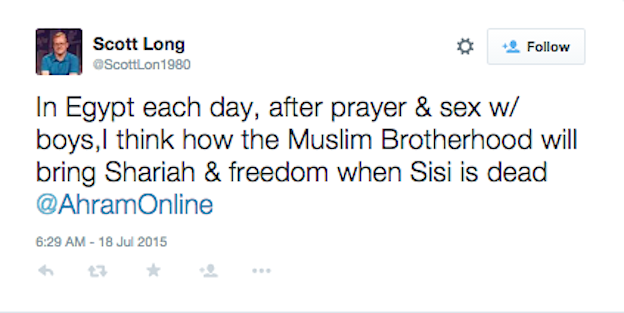
That one tweet could easily lead to a few decades in prison here. And the person who put my name to it appears quite conscious of the fact.
Who is behind this thing? I have no idea. But I know who likes it. Here are the account’s followers when I checked it on 16 July:
The third person who followed the account—out of seven at the time—was “All Equal.” That is the Twitter of Pliny Soocoormanee, who happens to be the personal assistant of Peter Tatchell, director of the Peter Tatchell Foundation. How he found out about this obscure account when no one else knew of it, and why it interested him so much, is a fascinating question. I cannot imagine the answer.
The morning after I criticized the Taheri story on Twitter, the account exploded with vengeful drivel, directed at people inside and outside Egypt (the one at top went to the country’s Ministry of Foreign Affairs):

But this BS is merely typical. Apparently I work for the Brotherhood, an illegal organization here:
.png)
My motives appear to be erotic as well as pecuniary.
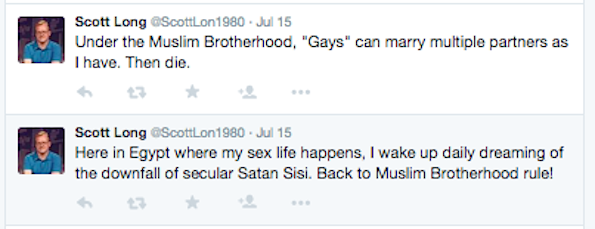
I am also an informer.
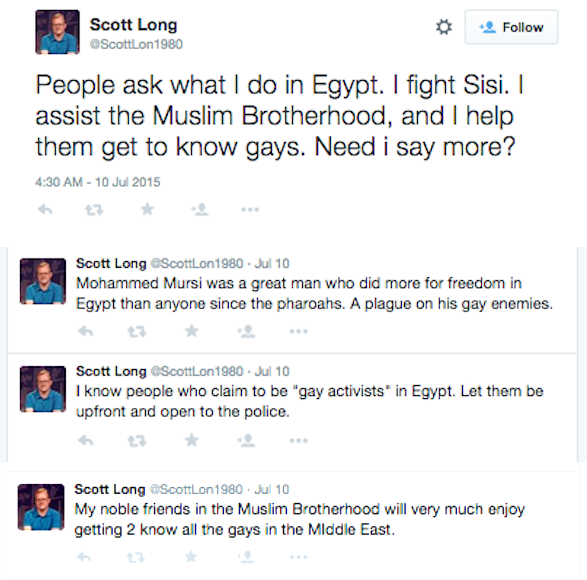
But mostly the account just strives to identify me with vicious anti-Semitic ravings, marking the intrinsic fascism of its maker’s mind. (Fascism is the politics of a cynical, corrosive narcissism. The mark of fascism is that it imagines all other opinions are as fascist as itself.)
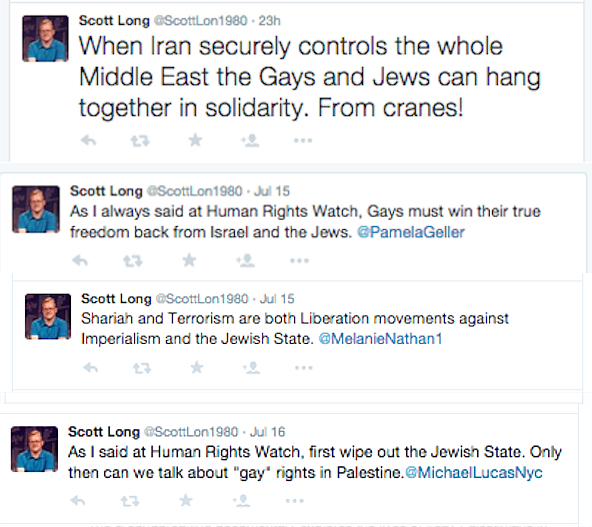
The account is pretty much coeval with the nuclear deal with Iran. Its first three tweets:
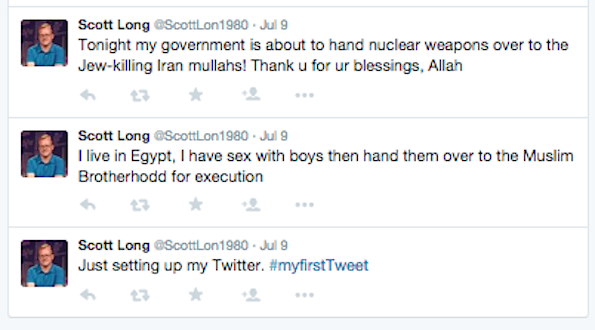
I would not pay attention to this crude fakery if it were not trying explicitly to incriminate me to Egypt’s government—which is arresting gay foreigners, and may not know the difference, or want to. I never cease to be surprised by the retributory malice of the Iran- and Islam-obsessed crowd, whether driven by ideology or the sheer love of headlines. They never stop.
Back in 2006, when Amir Taheri’s lies about Iran’s dress-code law were exposed, The Nation spoke to his PR agent. Accuracy on Iran is “a luxury,” she said. “As much as being accurate is important, in the end it’s important to side with what is right. What’s wrong is siding with the terrorists.” You see? It is us or them. Loyalty trumps truth. To expose useful lies is to take the terrorists’ side. And by that standard I am, of course, a terrorist.
Why does it matter? Because LGBT Iranians shouldn’t be exploited for propaganda. They lead lives seamed by danger, distinguished by courage; they deserve better than to be backgammon pieces, passive tokens stacked and shifted in a great-power political game. LGBT people should speak in their own voices, be masters and heroes of their own lives. That is what the liberation struggle is about.
The fact that nobody—not Tatchell, not Ben Weinthal, not Gay Star News—bothered to ask LGBT Iranian activists or groups what the truth was, or whether they wanted a demonstration, is appalling. But it is typical. The story of Western engagement with LGBT rights in Iran has been one of occupation and ventriloquism, not freedom. It’s long past time for the sick game to stop.
Postscript: The fake account seems to have been taken down not long after I first posted this. I do not know whether by its maker or by Twitter (of course I complained). But, in some form or another, they will be back.
[This article was originally published A Paper Bird and is re-posted with permission.]
